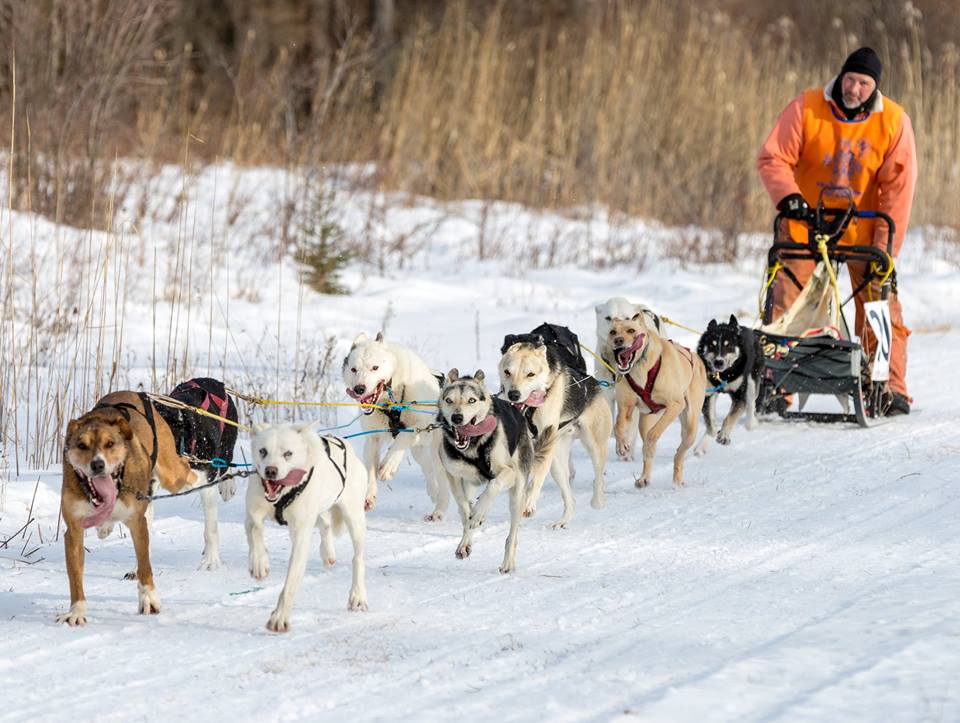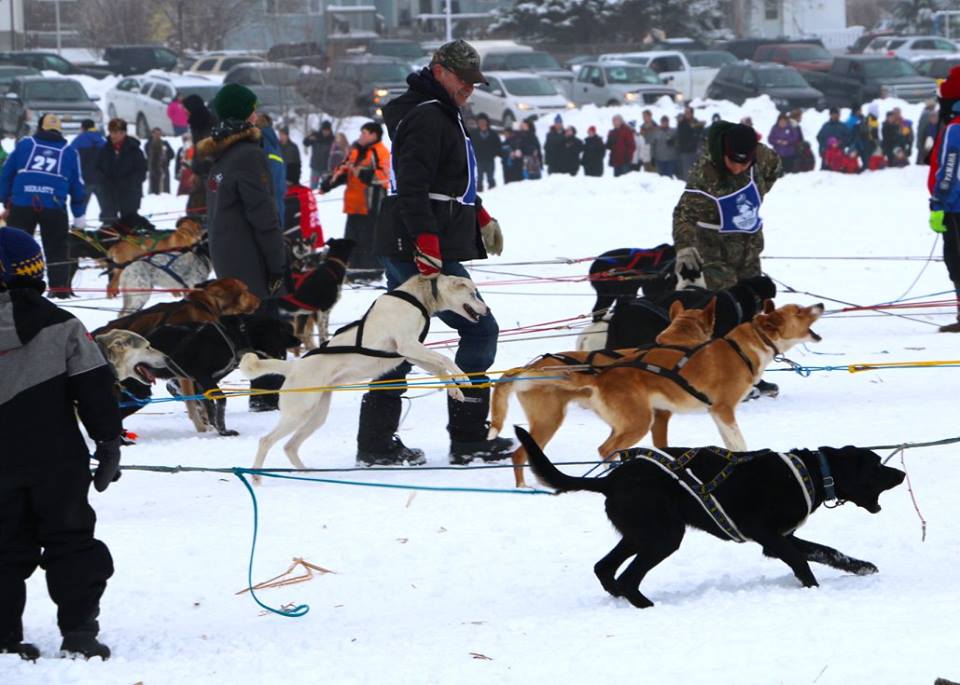Article 1: Northern Manitoba Trappers Festival and the World Championship Dog Sled Races

Once a year, proud Manitobans and some winter sports lovers from other places converge on the town of The Pas in the second week of February, braving the cold and testing their limits to see if they have what it takes to be a successful “trapper”. The annual Northern Manitoba Trappers’ Festival has been going strong for over 70 years with no signs of letting up; hosting more than two dozen events including moose calling, trap setting, fish filleting, canoe packing, ice fishing and axe throwing. The festival has something for everyone by way of events. However, the crowd’s favorite event of all time is the World Championship of Dog Sled Races.
The Northern Manitoba Trappers’ Festival did not always start out so large. If one were to ask the spectators attending the festival, one would hardly find a spectator who know anything about the origin of the festival. How did Trappers’ Festival come to be then? The idea behind the festival came about over one hundred years ago, precisely in 1916 (Lambert 2014). A handful of people met at the now-defunct Opasquia Hotel on Edwards Avenue to discuss the challenges the Town of The Pas was facing with fur exchange. The individuals present at the meeting thought it would be a great idea to look for an alternative community-wide event that would help keep community members engaged in the difficult winter months. They unanimously agreed to honour their culture and tradition by hosting a competitive dog race event, which came to be known as “The Pas Dog Derby”. The dog race event became an annual program until 1931, with the exceptions of 1917 and 1918 on account of World War I. In 1948, a cultural festival which includes the World Championship Dog Race was birthed, and has carried on without any further interruptions becoming what we now know as the Northern Manitoba Trappers’ Festival (Lambert, 2014).
From an outsider’s view, one could easily assume that managing a team of dogs would be easy. The mushers and their team of dogs make it seem effortless to work together, but this gives you a brief glimpse into how much dedication, trust and hard-work are actually required to be successful and avoid potentially career-ending (or worse) injuries. When an individual in attendance physically seeks out the mechanics of what is happening during a race, it becomes quite clear just how much the teams are synchronized. Every movement is fluid, natural and well-rehearsed. The amount of discipline required from all members of racing teams is clearly extreme. For instance, a typical sled team consists of six to eight determined and well-trained dogs that pull a musher over a certain distance. For the World Championship Dog race, the distance required is a grand total of 105 miles on a pre-set trail separated into three laps. One lap of 35 miles must be completed per day. The entire dog race event spans over three days in total (Northern Manitoba Trappers’ Festival, 2018).
Competing in this race is no easy feat, but the rewards and recognition help to keep the mushers focused. With prizes totalling over $52K, it’s no wonder the teams have their ‘eyes on the prize’. On top of monetary prizes, winners can expect to receive bragging rights that are supported with complete lists of current standings and previous years’ historical winners. The World Championship Dog Race is open to contestants from all over Canada and the United States with no restrictions on gender. The race is also affiliated with the International Federation of Sled Dog Sports for the past fourteen years, and it hosts The World Cup Series which includes thirty events in six counties (Northern Manitoba Trappers’ Festival, 2018).
Spectators can only hope for mild weather during the events and races to catch a break from usually frigid temperatures that can drop to around -45 ̊C (colder for a musher who is competing). Conditions vary on a typical race day but one thing is certain, there must be snow! A lack of snow would cause a cancellation in the long-running event and would be sure to disappoint everyone involved. But as most would agree, the safety of the mushers and their dogs is of utmost importance.
What makes the World Championship Dog Race so special? Asking this question will produce a variety of answers, but most reflect the same idea. Desarae Lambert, 2014 Fur Queen, graciously answered by saying that the dog races event is the most important aspect of the festival. “…this is the one event that draws the furthest competitors from all around the world, as well as visitors.” Lambert goes on to add that attendance around the races are incredible. Despite the freezing temperatures that are a norm around this time of year, they never stop a person from wanting to go out to support the teams that are competing. That statement rings true. As much as consumerism attempts to paint the image that on a cold winters’ day an individual should be found cuddled up on the couch in front of a fireplace reading a classic novel, (not that it is not a brilliant way to relax), during Trappers’ Festival you would easily find me (and hundreds of others) bundled up in too many layers to count watching our favorite events and cheering for all those competing.
I had the opportunity to experience my first Trappers’ Festival in the winter of 2013. As much as I was “prepared” to experience a tonne of events and activities, nothing could have truly prepared me for how much I would grow to love the festival based on my first-hand experiences. As an animal lover, the dog sled races became a quick favorite of mine. I learned fast that a community group known as The Pas Kinsmen works hard annually to make sure this event runs as smooth as possible. Fortunately for me, my father-in-law is a member of the group. The privilege afforded me a chance to see firsthand how the set-ups worked, and it also gave me the opportunity to volunteer with registering the mushers that came to our small town. Down at the trailers the first time, watching the mushers set up their teams, and anticipating the take-off of the dog race event, was an incredible experience which I will never forget. One thing is certain, the majority of people interviewed confirmed that the dog sled races event remains the most popular in spite of the frigid temperatures.
Celeste Atchison, a long-time resident said, “I have seen people out when it’s forty below. I think that we are used to how extreme the weather can be, and people just dress accordingly.” Kim Prychitko agreed by saying, “I don’t think it [weather] affects attendance. Maybe children if it’s bitterly cold weather. True die-hard fans, northerners, will attend.” Looking out into the crowds of people in attendance, you can expect to see a similar image: families and individuals, men, women and children alike bundled up in layers upon layers with almost every last inch of skin covered to avoid freezing. Oversized jackets, ski-pants, cold-certified boots, gloves and scarves made of thick comfortable materials are not only among the favorites, but also necessities to survive the weather. Another typical item worn for the festivities is fur, not only for added warmth but to avoid being thrown in ‘jail’ by the Keystone Cops.
When asked about the future of this specific event within the Trappers’ Festival, Atchison claimed, “as long as the Trappers’ Festival continues, so will the dog races. It is an important piece of the festival’s history.” Keegan Tritthart agreed that since the dog sled race event has survived this long, it can only continue to survive into the future.
It came as no surprise that the popular opinion of most people asked, without any sense of ambiguity, was the expression that the Northern Manitoba Trappers’ Festival will continue, including the ever popular dog sled races. Not only will it continue to grace our presence annually (and with hopefully adding more events, audiences and recognition), but it will continue to grace our hearts and souls. A continuation of this joyous festival equals a continuation of spreading an often-forgotten culture and way of life (in the Aboriginal culture, traditional stories and ways of life are to be passed on orally, not written down) to the hearts and souls of a wider demographic.
In conclusion, attending Trappers’ Festival, everyone feels at home. It doesn’t matter if you are from this area or not, the community welcomes you and makes you feel like one of its own and shares its excitement and history with you. There is truly an event or contest for every person irrespective of age, gender, or ethnicity. Trappers’ Festival is a time for people to come together despite the troubles in the world. Atchison opined that all you need to do is to bring your warm clothes and moose calling skills to join in with the fun that you are guaranteed to have!
References
Lambert, S. (2014, March 19). Manitoba History: The Northern Manitoba Trappers’ Festival: A Brief History. Retrieved from Manitoba Historical Society: http://www.mhs.mb.ca/docs/mb_history/15/trappersfestival.shtml
Northern Manitoba Trappers’ Festival. (2018). Dog Races. Retrieved from Trappers Festival:
http://trappersfestival.ca/?page_id=51
Northern Manitoba Trappers’ Festival. (2018). World and Manitoba Championship Race. Retrieved from Trappers
Festival: http://trappersfestival.ca/?page_id=1388

About the Author: Elizabeth Tritthart was born in Medicine Hat, Alberta and raised in Regina, Saskatchewan. She moved to The Pas with her husband in November 2017 to enroll in a Bachelor of Arts/Bachelor of Education program. She is passionate about animals and children and hopes to teach at the elementary to middle school levels.

Instructor’s Remarks: Elizabeth Tritthart was my student in the Academic Research and Writing (IDS.1003) course. Her article on the World Championship Dog Sled Races, an event that has become synonymous with the Northern Manitoba Trappers’ Festival in the town of The Pas, makes a great read for anyone desirous of an education on the subject. (Dr. Joseph Atoyebi)
